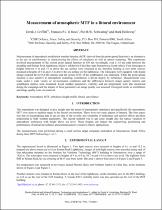JavaScript is disabled for your browser. Some features of this site may not work without it.
- ResearchSpace
- →
- Research Publications/Outputs
- →
- Conference Publications
- →
- View Item
| dc.contributor.author |
Griffith, DJ

|
|
| dc.contributor.author |
Le Roux, FPJ

|
|
| dc.contributor.author |
Schwering, PBW

|
|
| dc.contributor.author |
Holloway, M

|
|
| dc.date.accessioned | 2008-11-25T07:04:32Z | |
| dc.date.available | 2008-11-25T07:04:32Z | |
| dc.date.issued | 2008-09 | |
| dc.identifier.citation | Griffith, DJ, Le Roux, FPJ, Schwering, PBW and Holloway, M. 2008. Measurement of atmospheric MTF in a littoral environment. Electro-Optical and Infrared Systems: Technology and Applications V Conference. Cardiff, Wales, UK, 15-18 September 2008, pp 8 | en |
| dc.identifier.isbn | 9780819473455 | |
| dc.identifier.issn | 0277-786X | |
| dc.identifier.uri | http://hdl.handle.net/10204/2625 | |
| dc.description | Copyright: 2008 International Society for Optical Engineering | en |
| dc.description.abstract | Measurement of atmospheric modulation transfer function (MTF) derived from the point spread function is an alternative to the use of scintillometry in characterizing the effects of turbulence as well as optical scattering. This experiment involved measurement of the system point spread function at 630 nm wavelength, over a 1.8 km path between the shoreline and Roman Rock lighthouse, which is offshore in False Bay near Simonstown, South Africa. Four telescopes at heights between 4 m and 14 m above the sea surface were mounted at the shoreline looking at two point sources mounted at heights of 6 m and 13 m above the sea surface on the lighthouse. The telescopes were equipped with digital charge-coupled device (CCD) cameras and the system MTF of the combination was measured. While the point spread function is also sensitive to atmospheric scattering, scintillation is driven largely by turbulence. Measurements were made under a wide variety of environmental conditions and the differences between image quality metrics and scintillation metrics were examined. Local weather parameters, visibility and sea temperature were also monitored during the campaign and the impact of these parameters on image quality was assessed. Divergent trends in scintillation and image quality were encountered | en |
| dc.language.iso | en | en |
| dc.publisher | International Society for Optical Engineering | en |
| dc.subject | Modulation transfer function | en |
| dc.subject | Turbulence height profile | en |
| dc.subject | Littoral surveillance | en |
| dc.subject | Charge-coupled device | en |
| dc.title | Measurement of atmospheric MTF in a littoral environment | en |
| dc.type | Conference Presentation | en |
| dc.identifier.apacitation | Griffith, D., Le Roux, F., Schwering, P., & Holloway, M. (2008). Measurement of atmospheric MTF in a littoral environment. International Society for Optical Engineering. http://hdl.handle.net/10204/2625 | en_ZA |
| dc.identifier.chicagocitation | Griffith, DJ, FPJ Le Roux, PBW Schwering, and M Holloway. "Measurement of atmospheric MTF in a littoral environment." (2008): http://hdl.handle.net/10204/2625 | en_ZA |
| dc.identifier.vancouvercitation | Griffith D, Le Roux F, Schwering P, Holloway M, Measurement of atmospheric MTF in a littoral environment; International Society for Optical Engineering; 2008. http://hdl.handle.net/10204/2625 . | en_ZA |
| dc.identifier.ris | TY - Conference Presentation AU - Griffith, DJ AU - Le Roux, FPJ AU - Schwering, PBW AU - Holloway, M AB - Measurement of atmospheric modulation transfer function (MTF) derived from the point spread function is an alternative to the use of scintillometry in characterizing the effects of turbulence as well as optical scattering. This experiment involved measurement of the system point spread function at 630 nm wavelength, over a 1.8 km path between the shoreline and Roman Rock lighthouse, which is offshore in False Bay near Simonstown, South Africa. Four telescopes at heights between 4 m and 14 m above the sea surface were mounted at the shoreline looking at two point sources mounted at heights of 6 m and 13 m above the sea surface on the lighthouse. The telescopes were equipped with digital charge-coupled device (CCD) cameras and the system MTF of the combination was measured. While the point spread function is also sensitive to atmospheric scattering, scintillation is driven largely by turbulence. Measurements were made under a wide variety of environmental conditions and the differences between image quality metrics and scintillation metrics were examined. Local weather parameters, visibility and sea temperature were also monitored during the campaign and the impact of these parameters on image quality was assessed. Divergent trends in scintillation and image quality were encountered DA - 2008-09 DB - ResearchSpace DP - CSIR KW - Modulation transfer function KW - Turbulence height profile KW - Littoral surveillance KW - Charge-coupled device LK - https://researchspace.csir.co.za PY - 2008 SM - 9780819473455 SM - 0277-786X T1 - Measurement of atmospheric MTF in a littoral environment TI - Measurement of atmospheric MTF in a littoral environment UR - http://hdl.handle.net/10204/2625 ER - | en_ZA |






